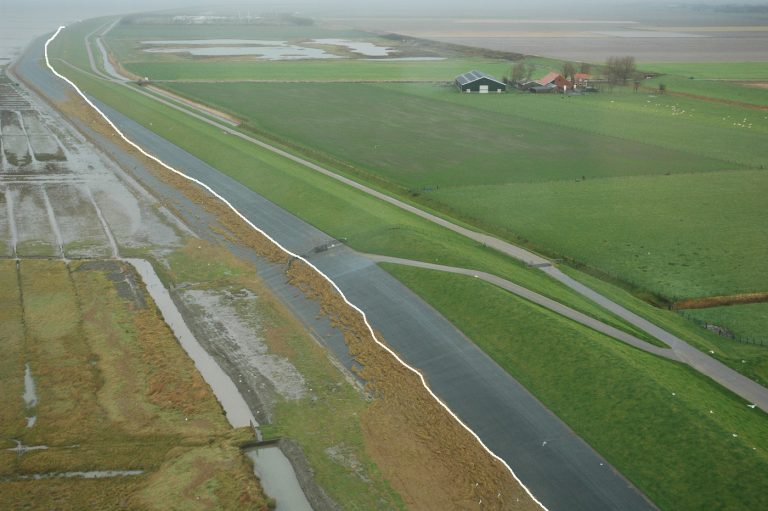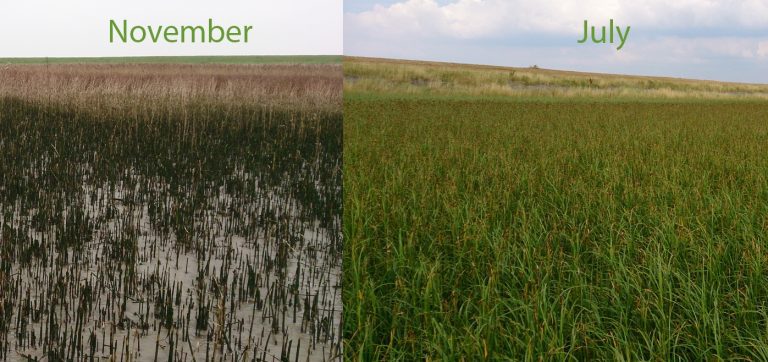A green foreshore reduces the impact of waves on a dike, found PhD student Vincent Vuik. What’s more, foreshores such as salt marshes grow with rising sea level.
Vincent Vuik (left) and two students on location. (Photo: Collection Vuik)
Concrete dams, steel doors, and basalt-clad shores. The Dutch Delta Works were a poster child of hard concrete coastal defence. Even before the construction was complete, ecologists drew attention to protecting the quality of sand banks, vegetation, and dunes. Instead of dominating nature, a new paradigm was born: building with nature.


In his PhD thesis Building safety with Nature, PhD candidate Vincent Vuik combines sand with concrete, ecology with safety, and vegetation with dikes, into hybrid shore protections. He concludes that the most effective foreshore solutions combine natural and artificial elements.


Vuik also asserts that nature-based flood defences are more adaptive than hard structures and therefore more attractive when confronted by accelerating sea level rise. Could hybrid dikes be the answer to our 21st century challenges?


One aerial photo from the Wadden Sea dike tells the whole story. The greenish brown drift lines on the dike shows how high the waves came during a storm. To the right, this is about half way up the asphalt. But further on, to the upper left, the waves reached the top of the asphalt. Why the difference?
Wave runup is reduced by a combination of wave breaking on the high foreshore and wave damping by marsh vegetation. There is a marsh nearby and a lower mudflat without vegetation further on. Vuik concludes that foreshore vegetation can reduce wave heights in storms by more than 50%. He based his conclusions on three years of storm data from the Wadden Sea and Western Scheldt.


Unfortunately, the vegetation is at its best in the summer when the sea is relatively calm. During winter, strong waves may break the stems and ravage the vegetation. The extent of damage depends on the plant species and can be calculated by a mathematical model that Vuik developed.


But even a barren sandy foreshore will reduce the wave runup because waves will break before they reach the foot of the dike. Currently, a dike reinforcement is under construction along the Houtrib dike between Lelystad and Enkhuizen. The dike is enforced by large depositions of sand on both sides. A measuring campaign plans to establish how equilibrium forms between sand and water in this non-tidal situation.
Vuik says that in the Netherlands, salt marshes and other forms of foreshores are most effective for relatively sheltered flood defences like the dikes surrounding the Wadden Sea and the Eastern and Western Scheldt. They are not effective for defences along open coastlines due to the high waves and strong currents in storm conditions that would eradicate the plants.
In countries like the USA or some developing countries in Asia which flood every 10 years, salt marshes or mangrove forests have the potential to reduce the flooding frequency to once every hundred years. And because the vegetation retains sediment from the water, overgrown foreshores will simply keep pace with sea level rise.
- Vincent Vuik, Building Safety with Nature, Salt Marshes for Flood Risk Protection, PhD supervisors Prof. Bas Jonkman and Dr Bas Borsje (University Twente), 27 March 2019, 09:30, Aula. Vuik’s research was funded by NWO.
Do you have a question or comment about this article?
j.w.wassink@tudelft.nl


Comments are closed.